India's best track bikes 2016
A line-up of bikes take to the track to prove their worthiness at the Autocar India Track Test. We bring you up to speed with the event.
Published On Sep 15, 2016 07:00:00 AM
31,322 Views
Follow us on



Motorcycles in India seem to be getting better and more exciting with every passing year. Today, the very best and the very latest motorcycles from all over the world are available in our market. This was quite evident in the line-up we had assembled for the Autocar India Track Test. It isn’t just the 200hp machines that make motorcycling richer; even the smaller motorcycles display the maturity and ability required to impress. All through the year, we test these motorcycles and judge them on the basis of their overall usability, but come August and it’s time to judge the sportier motorcycles on the basis of their track-worthiness and their ability to thrill.
This task, as before, is handled by the one man we think can do justice to it, Rajini Krishnan. A veteran motorcycle racer with nine Indian National Road Racing Championships to his credit, Rajini also earned the title of Malaysian Superbike Champion in 2015. This year, he is defending his Malaysian title, and has found success in the China SBK series too. Despite the fitness expected of a sportsperson who trains for three-four hours a day, testing this line-up was nothing short of a mega task for the racing superstar. Let’s see how things turned out.
SUZUKI GIXXER SF (REAR DISC)
2m34.68s
Track rating 9/10
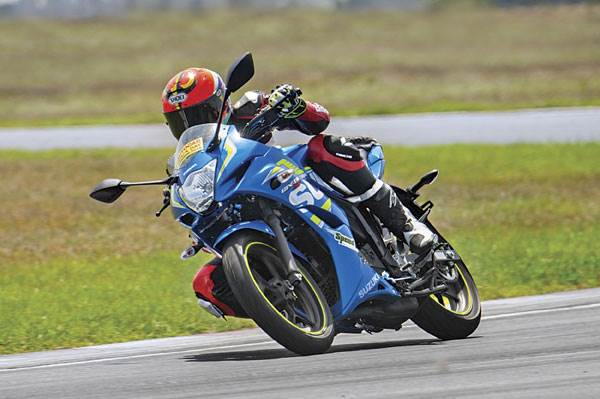
"It’s very slim, handles well and has very good power for its class."
The fully faired version of one of the most exciting bikes to be launched in the 150cc category in recent years, the Gixxer SF is now equipped with a rear-disc brake to provide improved stopping power. The grunty motor and impeccable handling package still makes for a potent combination keeping it at the top of this class. According to Rajini though, on a small bike like this, the rear-disc brake makes no real difference on the race track. With that clarified, the fact that his best time on this bike was almost 11 seconds slower than what he managed on the SF last year, it was woefully apparent that the track, after the recent resurfacing, was too slippery for fast lap times, on
smaller-capacity bikes at least.
YAMAHA YZF-R15 S
2m25.75s
Track rating 7/10
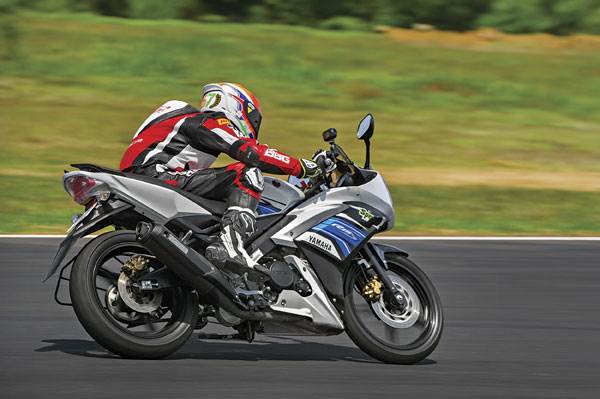
"The handling isn’t that great. The v2.0’s handling is much better."
With a lot of riders complaining about the R15 v2.0’s tall rear seat and cramped riding position, Yamaha brought the ergonomics of the first-generation bike back in the form of the YZF-R15 S. Though the mechanicals are almost the same on both the bikes, the 149cc, liquid-cooled, four-valve motor has been slightly detuned and now makes marginally less power (16.6hp vs 17hp). Rajini wasn’t too pleased with the lack of refinement in all the gears, brought about by this retuning. While he praised the improved comfort levels, it was clear that they came at the price of outright lap times on the track; an area that the v2.0 still dominates.
YAMAHA YZF-R3
2m13.01s
Track rating 8/10
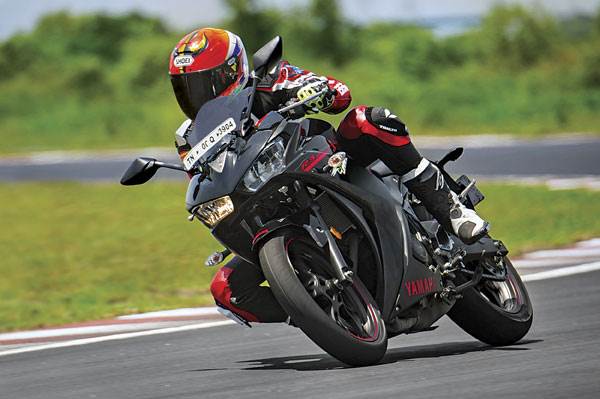
"The engine is really special and deserves a better- equipped and sharper chassis."
After much ado, Yamaha entered the Indian quarter-litre bike segment last year with the Yamaha R3. This bike packs a wonderfully tractable 321cc, liquid-cooled, parallel-twin motor that puts out 42hp of peak power. The engine delivers an unparalleled riding experience, but the choice to stick with conventional forks, a simple diamond frame chassis and comfortable ergonomics has made the R3 an all-rounder, while taking some meat away from its sports-bike credentials. And our champion racer was quick to lament the lack of higher-specced componentry to make best use of that phenomenal engine, especially considering the rather high asking price for the motorcycle. Around the track, Rajini’s observations were that the suspension felt too soft while the tyres felt very inadequate.
KTM RC 390 (SLIPPER CLUTCH)
2m07.38s
Track rating 9/10

"Thanks to the slipper clutch, the RC can slide very smoothly into corners."
The RC 390 has received a few updates since its launch. But the most important upgrade this year was the inclusion of a slipper clutch – something that is certain to strengthen the bike’s strong track-friendly disposition. And while the 373.2cc, single-cylinder, liquid-cooled motor makes the same figures – 43.5hp of power and 35Nm of torque – it certainly has been tweaked in the interest of making it smoother. However, the power delivery now feels much flatter, and effectively sluggish, which is exactly what you don’t want on the track, as Rajini explained. But he was happy about the way the slipper clutch allowed him to downshift multiple gears before corner entry, without any rear wheel hop.
TRIUMPH THRUXTON R
2m04.1s
Track rating 8/10
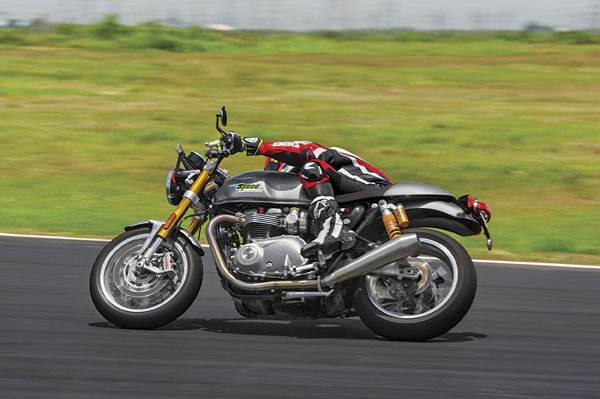
"It’s very easy to flick into turns; just a little input is enough."
The Thruxton R is a shining example of what’s possible when a bike maker knows that sheer nostalgia is not enough to make a great modern-classic motorcycle. Armed with top-notch components such as inverted Showa big piston forks, a pair of fully adjustable Ohlins rear shock, Brembo brakes with monobloc calipers and super sticky Pirelli Diablo RossaCorsatyres, the Thruxton R is a hoot in the handling department. And it’s all wrapped neatly in a delightful old-school package. Rajini was blown away by the amount of speed he could carry through the corners and couldn’t stop raving about the handling package, especially how the bike displayed oodles of confidence during corner entry.
At the heart of the Thruxton R is a superb 1,200cc, parallel twin motor making 97hp of power and 112Nm of torque, and most of the latter is made from very low rpms. While the torque spread is impressive, on the race track its shorter gearing does hamper its lap times a bit. Combined with a light crankshaft, the motor hits its lowly 7,000rpm redline rather quickly. Given a couple of thousand more revs to play with, Rajini believed the Thruxton R would be able to set much faster lap times.
KAWASAKI NINJA ZX-14R
2m01.01s
Track rating 7/10

"Mad top-end power and smooth too; but feels heavy."
The king of the drag strips has the psychological and hardware edge. We were curious as to how things would turn out between the Kawasaki and the ’Busa. Rajini too, found the more relaxed ergonomics of the Kawasaki to be very apt for the road. However, the mad top-end power, from 8,000-12,000rpm was something the racer appreciated immediately. The refinement and the smooth power deliver at lower revs was the icing on the cake. However, Rajinifelt that the big engine’s weight was quite apparent. That didn’t stop him from attacking corners and confessed that he was surprised at how well this big bike turned in.
SUZUKI HAYABUSA
1m56.74s
Track rating 8/10
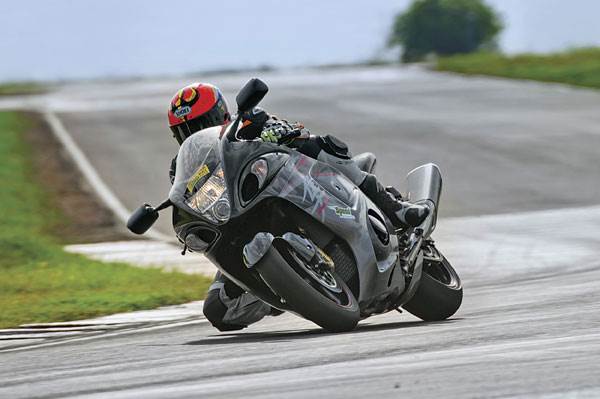
"I thought it would be very difficult in corners. But, it’s amazing!"
Suzuki’s Hayabusa doesn’t have age on its side. This legendary motorcycle – although in its second generation – is lagging behind its competition in terms of technology and horsepower. Nonetheless, the way the chassis and engine complement each other on the track caught Rajini by surprise. He found that the ’Busa was much quicker to turn in, compared to the 14R. The 1,340cc engine’s linear power delivery helped him get on the gas more aggressively too. More grunt at the bottom, meant that in tighter sections he could use a gear higher than in the 14R as the revs climb quicker. Interestingly, Rajini was quite surprised by the ’Busa’s lap-time advantage, and said that he didn’t have to work too hard for it.
MV AGUSTA F4 R
1m53.11s
Track rating 7/10
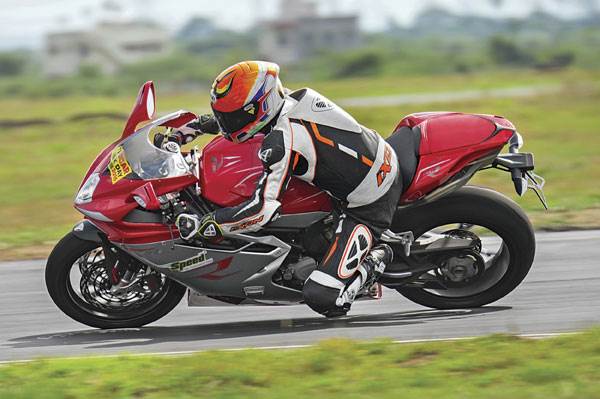
"Bike feels heavy and power is sharp; becomes difficult to find a rhythm."
The MV AgustaF4 has its origins rooted in the last decade. But MV has updated the motorcycle to keep pace with the new breed of superbikes. The use of an IMU to offer traction control, rider modes and a quickshifter help make the most of the 195hp on offer. However, in places its age peeps out at you, at standstill and on the go. Rajinifelt that although the F4 was precise, it took effort to get turned. A malfunctioning quickshifter hampered Rajini and held the F4 from clocking faster lap times. The aggressive power delivery ate into its corner speed too. Nonetheless, Rajini was smitten by the F4s top end power and aural note.
KAWASAKI NINJA ZX-10R
1m50.5s
Track rating 10/10
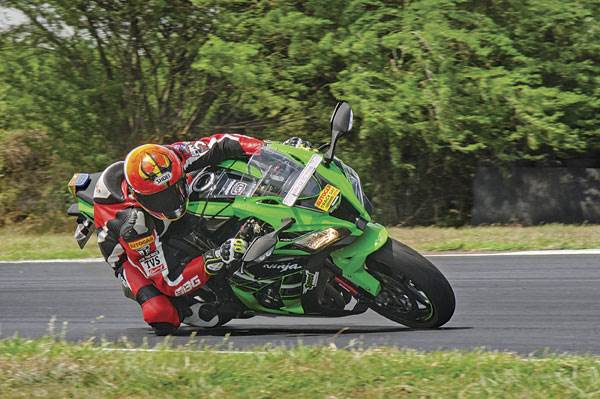
"Great setup and handling! That’s why Kawasaki is winning in WSBK too!"
Rajini is no stranger to the Kawasaki ZX-10R and knows what makes the 2016 bike a better track bike. Although peak power is still 210hp, the difference in speed between last year’s bike and this year’s bike was quite apparent. The revised gearing helped it get better corner exits; a vital point at the MMRT. But Rajini felt that the first gear was still too tall. The new ZX-10R’s slimmer design also helped him attack better. However, its true potential was left untapped as the worn tyres lacked grip and needed to be nursed through corners and at corner exits. Nonetheless, the ZX-10R proved that it is a rapid machine with cutting-edge technology and more. Impressive considering the price it comes at.
APRILIA RSV4 RF
1m50.35s
Track rating 10/10
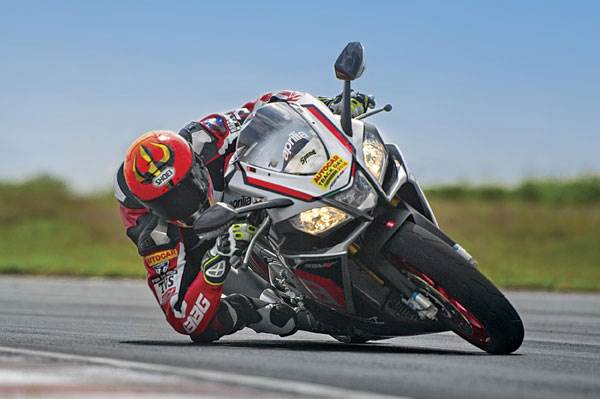
"The V4 provides a lot of torque in the mid-range; perfect for this track."
Aprilia’s RSV4 RF is a monster of a machine, loaded with race-spec hardware and technology. We were expecting it to be a close battle between the Kawasaki and the Aprilia. Although Rajini, felt that the Aprilia would have an advantage at Chennai. The reason for that was the RSV4’s incredible 65deg V4. No, it wasn’t because of the 201hp on tap, but because of the grunt that the V4 would provide at lower rpms. Rajini found the RSV4 very quick to rev from 5,000 to 10,000rpm. On this tight track (for these bikes), with no real flowing corners, the quick throttle response of the V4 was very helpful.
The Aprilia has been at the forefront of using the digital world to give it an edge. While the list of adjustments isn’t as wide as on the 10R, the RSV4 feels at the sharp end of the electronic-aids edge even today. Rajini rode the RF in Race mode with ABS switched off; the Aprilia was the only motorcycle to offer switchable ABS. He found he could ride without interference from the traction control and found that he could get on the gas quite early. Like the ZX-10R, from the moment you get on the Aprilia, the race-track-oriented focus is apparent. The seating posture is aggressive, albeit slightly more roomy than the 10R with regards to the seat to footpeg relationship. Overall, Rajini preferred the turn in of the Kawasaki, but he was absolutely wowed by the stoppers on the Aprilia.
Rajini’s fastest lap was set on his first hot lap and said that it didn’t even feel like he was pushing – a sign of the RSV’s composure. He felt he could have gone couple of seconds faster, but a front-end slide in C2 – owing to the slippery nature of the track – halted that progress. Nonetheless, we have a champ. The Aprilia RSV4 RF isn’t just the fastest motorcycle at the Autocar track day, but the fastest overall. Score.
Reference bikes
There were a lot of questions swimming around in our heads as we prepared for the track test. First, would the track be ready on time? The entire MMRT had been resurfaced, but at the first race weekend a few issues cropped up and it had to undergo emergency repairs. Second, what kind of grip would be on offer? As pretty much the first ones out on the track, the track wouldn’t be rubbered in and grip could be inconsistent. So, to see what the difference the new track surface would make to lap times we chose to have reference bikes. These were motorcycles we had tested the previous year and they would give us an idea of variations, if any. As it turned out, in the cooler morning temperatures, the Gixxer SF ran slower than the previous year. Rajini found the track to be quite slippery and grip to be inconsistent. Robbed of the vital “feel” ,Rajini felt corner speeds and overall lap times were compromised as a result. The lap times of other smaller bikes bore this out as well.
The Suzuki GSX-S1000 was used to set a benchmark for the bigger bikes and clocked a 1m56.13s lap, virtually identical to the previous year’s time. Rajini felt that even though the grip remained inconsistent, the higher quality tyres on the big bikes helped them compensate for the grip conditions. Even then, he encountered several near misses while trying to get the best lap.
Kartikeya Singhee
Also read:
Copyright (c) Autocar India. All rights reserved.



Comments
Member Login
Personal Details
No comments yet. Be the first to comment.